I painted this German tank –one of my favorites WWII tanks, although it was a prototype– two years ago. It is a E-25 tank, produced in 15mm by Khurasan Miniatures. Although I have already published similar painting guides in my blog, I think that there is always something new to learn. The main topic of this article is the combination of the hairspray technique (or chipping effect fluid) with masks to create worn tritonal camouflage.
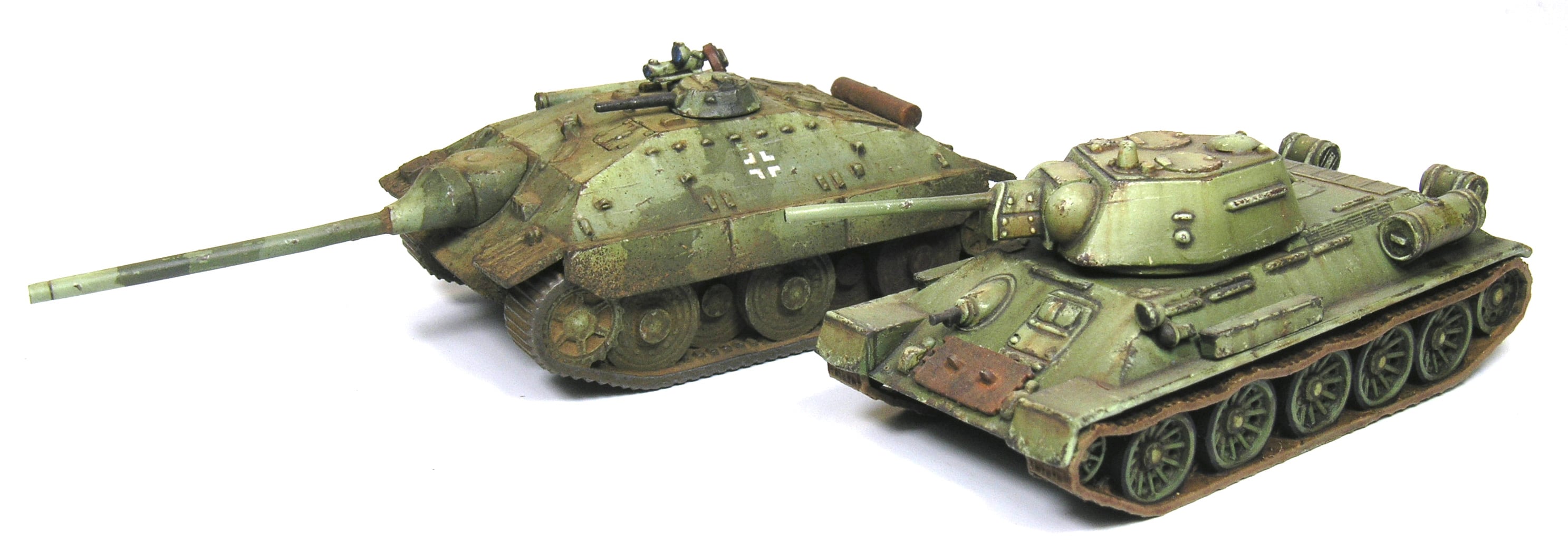
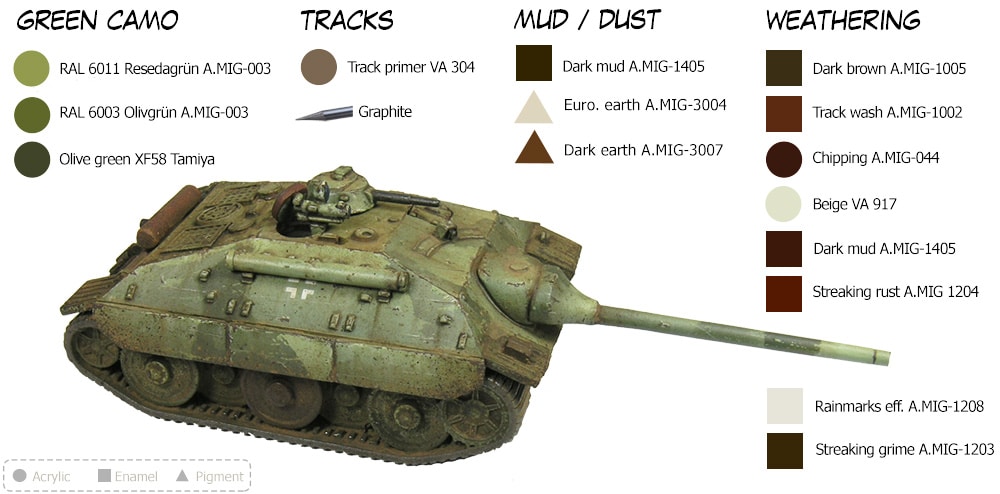
Step 1 – Preparation
We remove all imperfections from the model with a modelling knife and files. Then, glue some parts such as hatches, but it is advisable to paint separately other big elements such as the tracks (it will be easier). Finally, we apply the primer. This step is mandatory because we are going to use very aggressive techniques later; and therefore, we need to have a good foundation to avoid surprises. I have used grey primer, a neutral color, because it is covered easily by any other colors .
Step 2 – Camouflage
I decided to paint this “paperpanzer” with a “what if” camouflage I found in a book of tank profiles. Basically, it is a tritonal camouflage with hard-edge ameboid spots on three different shades of green. We can easily do it using an airbrush and masks with Blu-Tack (check this post).
First, we paint the basic color of the tank. In my case, I chose the lightest green. It does not matter which color we chose, since each green shade should cover the same area (1/3 of the surface). To creates volume, by painting shades and lights, I followed the Color Modulation technique (read more here). The result is not realistic, but it is very striking, ergo it is perfect for ours 15mm scale models as they will be perfectly visible in the battlefield three foots away. Additionally, consider that after applying the weathering effects the most part of the striking contrasts are attenuated.
First, I applied a dark green to create the shades (for example, A.MIG-915), then I painted the base color or intermediate with Resedagrün (A.MIG-003), and finally the highlights were done with A.MIG-917. If you do not have all these paints, you can use any green and mix it with ivory to create a paler green or dark brown to create a darker green. I prefer to use these bottles because I save time.
Now, we can do something very interesting and realistic: chippings effects in the remaining two shades of green of the camouflage, revealing the initial light green color. We are going to do it by using the “Chipping effects fluid” from AMMO that resembles the hairspray technique (more about this here). After applying a thin layer of satin varnish to protect the previous work, we airbrush two thin layers of chipping fluid over the whole vehicle.
We need to be quick at this point. We do not want the chipping fluid to sit for long or otherwise it will be complicated to work with it. To create hard-edge camo spots we can use masks with masking tape, paper or auto-adhesive putties (such as Blu-Tack). In this case I prefer to use an auto-adhesive putty due to the uneven surface of the tank -full of details- and the shape of the camouflage spots. You can read more about how to do this type of camo here. We cover 1/3 of the tank, leaving exposed another 2/3s (remember, we will paint camo spots with another two different green shades and each green should cover the same area, 1/3 of the total).
Now we apply the second camouflage color, a mid green. I decided to use Olivgrün (A.MIG-003) which was consecutively highlighted by mixing it with A.MIG-917 in the same proportion. I did not painted shades here to keep the layer of paint on top of the chipping fluid thin. Remember to dilute your paints with water. In fact, thinned paint facilitates the creation of smoother transitions. It is very important to follow the same lightning style we previously used on the base color, so that all the colors of the camo are coherent.
We repeat the same masking process, covering another 1/3 of the surface. We do it carefully to avoid moving or modifying the previous masks.
Finally, we paint the darkest color of the camo. For this I used Olive green (XF-58, Tamiya), followed by A.MIG-917 for the highlights. Again, no shades. We continue following the same lightning pattern.
Now the funniest part begins! We can easily remove the mask by pulling it. Unfortunately, sometimes we can accidentally remove part of the paint. Do not worry. Just repaint that part with a brush and the same paints or something similar. If it is not perfect, it is fine. We can still fix the problem later during the weathering effects steps.
The chipping fluid lasts active for several hours, but we should not waste time. Once the camouflage is ready and the putty has been removed, we can start doing the chipping effects and scratches. We need to dissolve the chipping fluid by adding water on the surface using a brush. Then, using a toothpick we carefully remove the paint from the darker green colors. We work little by little each area.
After finishing the chipping effects we paint the tracks and exhausts. For example, for the former we can use a medium brown such as Track primer (VA 304), and for the latter flat brown (984, Vallejo). Now it is also the moment to apply decals or stencils. Notice that I have painted some wheels in red primer by airbrushing flat brown. Finally, before starting the weathering effects, we apply a new layer of satin varnish to protect the previous work.
Step 3 – Weathering
The first step to bring to life our tiny model is to stand out the recesses and details with a dark wash. We apply “pin wash”, meaning that the wash is applied only in the recesses.I prefer to use enamel washes rather than acrylic ones, because although enamels take hours to dry in comparison to acrylics, we can remove the excess of the wash afterwards (acrylic paints dry in second and we cannot remove them at all). More about this topic here. I have used a dark brown wash for green surfaces (A.MIG-1005) and a reddish wash for the tracks (A.MIG-1002).
After1 hour we can start remove the excess of enamel. We use a brush or cotton swab moistened with white spirit. If we apply vertical strokes we can simultaneously create some interesting streaking effects (although this is not the main purpose now). If for any reason we have removed too much wash or some details were not marked as expected (sometimes the recesses are not deep enough to accumulate the wash), we can re-paint that part using an acrylic paint and a very thin brush. This is much faster than applying a new layer of enamel, waiting until is dry and then remove it.
Next, we create the classic chipping effects and scratches using acrylic paints. We can split this technique in two steps: (1) apply a light color (we can just mix the base color with a bit of white) and then (2) apply a dark color (such as A.MIG-044 or Dark Oxide 302 Vallejo). The first color simulates superficial scratches and chippings, while the dark one represents deeper ones where the bare metal is exposed. I painted them using a fine brush. However we can also use a sponge for a quick job: take some paint with the sponge, remove the most part on a paper, and then start stippling movement on the surface of the vehicle. However, I do not like the sponge technique because we do not have control (with the brush the control is absolute). Regardless of the approach you decide to follow, note that these effects must be very small as the scale, 1:100 or 15mm, is also very small. And specially for this technique, remember that “less is more”. We do not have to paint scratches everywhere! Focus on the more exposed areas, such as hatches or side skirts.
 To represent dirty and the general exposition of the vehicle to the environment we can apply streaking effects. Once more, we can use enamels to obtain better results because we can easily blend this type of paint with a bit of thinner. To simulate streaking effects I normally use three or four different enamels (depending on the environment). For example, brown to simulate dirt, beige to represent dust, and red brown to simulate rust. The idea is to combine several colors to obtain a more realistic result. To apply the streaking effects first we paint lines only on the vertical panels (forget about horizontal ones for now).
To represent dirty and the general exposition of the vehicle to the environment we can apply streaking effects. Once more, we can use enamels to obtain better results because we can easily blend this type of paint with a bit of thinner. To simulate streaking effects I normally use three or four different enamels (depending on the environment). For example, brown to simulate dirt, beige to represent dust, and red brown to simulate rust. The idea is to combine several colors to obtain a more realistic result. To apply the streaking effects first we paint lines only on the vertical panels (forget about horizontal ones for now).
After 5 minutes we can start blending the streaking effects lines using a flat brush moistened with white spirit. We use a flat brush and apply vertical strokes. We will eliminate the most part of the enamel, but do not worry about it. This effect must be very subtle. And we can always repeat these two steps several times to gain intensity. Additionally, we can create individual streaking effects using a fine brush to shape and blend them without removing too much paint. These will be more striking and will serve to create points of interest. We will apply only a few of these.
In this picture you can see the final result after applying a couple of layers of “general” streaking effects and then a few individual and more striking ones. The variety is very important.
And, what about the horizontal surfaces? we cannot create streaking effects there, but utilizing the same enamels we can represent dirt or corrosion around different elements, such as the hatches. We apply a little bit of enamel around the detail and after 5 minutes we blend it with a brush moistened in white spirit.
Another interesting effect we can do is dust. We can easily represent it with pigments. There are several ways to use them. In my case I applied them like a wash after dissolving a couple of earth-colored pigments with White Spirit. I applied the wash in the lower part of the tank, side skirts and around some details on the horizontal surfaces (where the dust would tend to accumulate).
Pigments require several hours to dry completely and by then the result will be something like in the following picture. It looks terrible, right? Do not worry, it is normal.
Now we can soften the effect with a cotton swab to remove the excess of pigment except from the areas surrounding the details (the cotton cannot reach these parts). In the case of the side skirts, we do it careful and only remove the upper part of the dusty area. Now it is not that bad, right?
Finally we can add splatter effects as we have discussed here.
Step 4 – Tracks
If you remember, we painted the tracks in grey-brown and applied a reddish wash. Now, is the moment to add dust effects. We use the same mixture of pigments and White Spirit we used previously that is generously applied on the tracks and wheels. Once the pigments are totally dry we remove the excess with a cotton swab.
We can use a graphite pen to simulate the metal shine of the tracks. We apply it only over the exposed parts, using it horizontally. This effect is very simple and at the same time realistic.
Now, our tank is ready! However, note that we can easily ruin the splatter and dust effects when holding the tank with our hands. We have not applied any varnish at the end. We could apply it, but then we will ruin the effects done with pigments (the pigment would absorb the water and becomes darker). An alternative solution is the Pigment Fixer A.MIG-3000, which can be applied by capillarity on top of the pigments and splatter effects. This product glues the pigments very effectively without altering the color.
Final photos
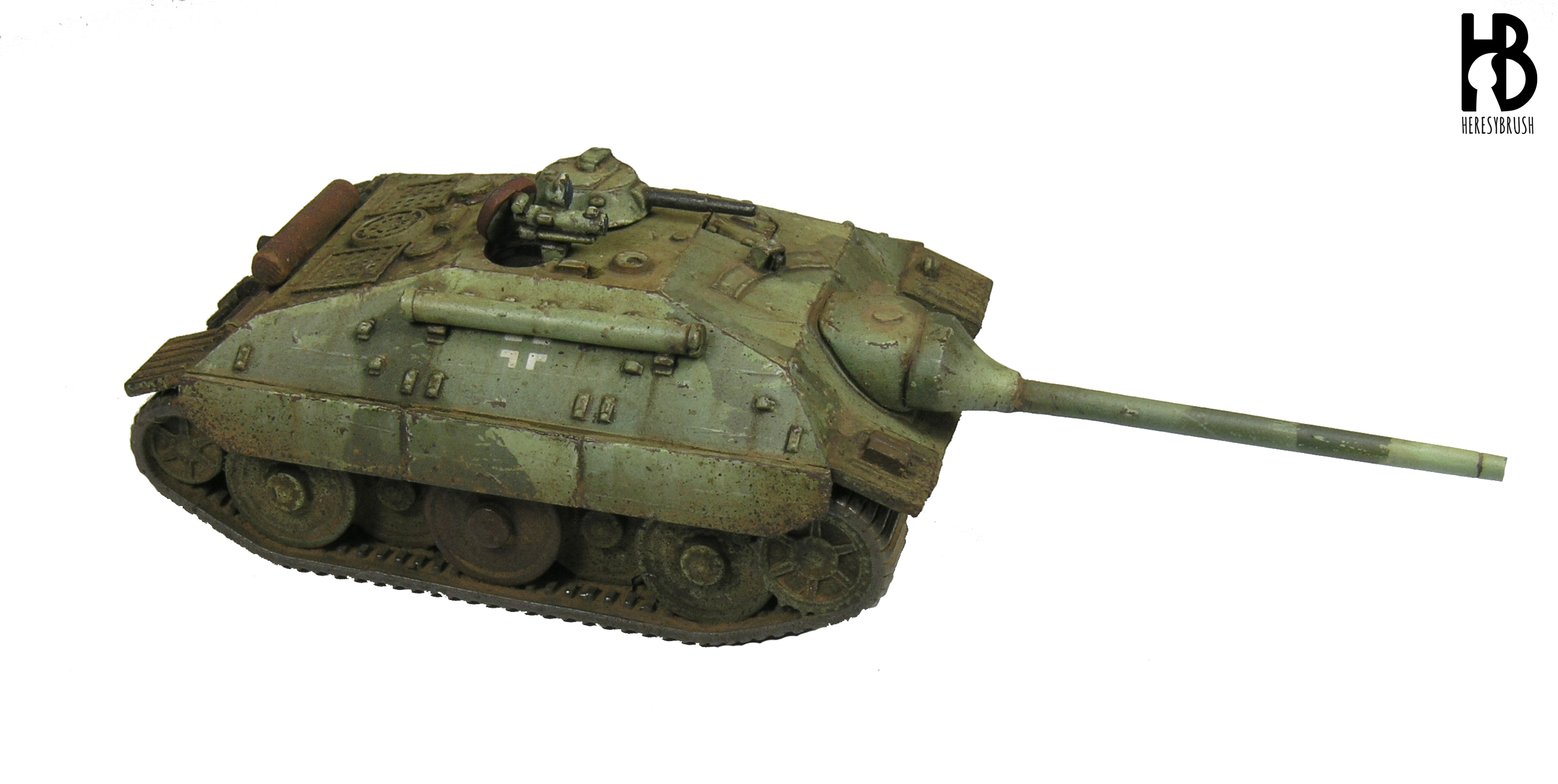







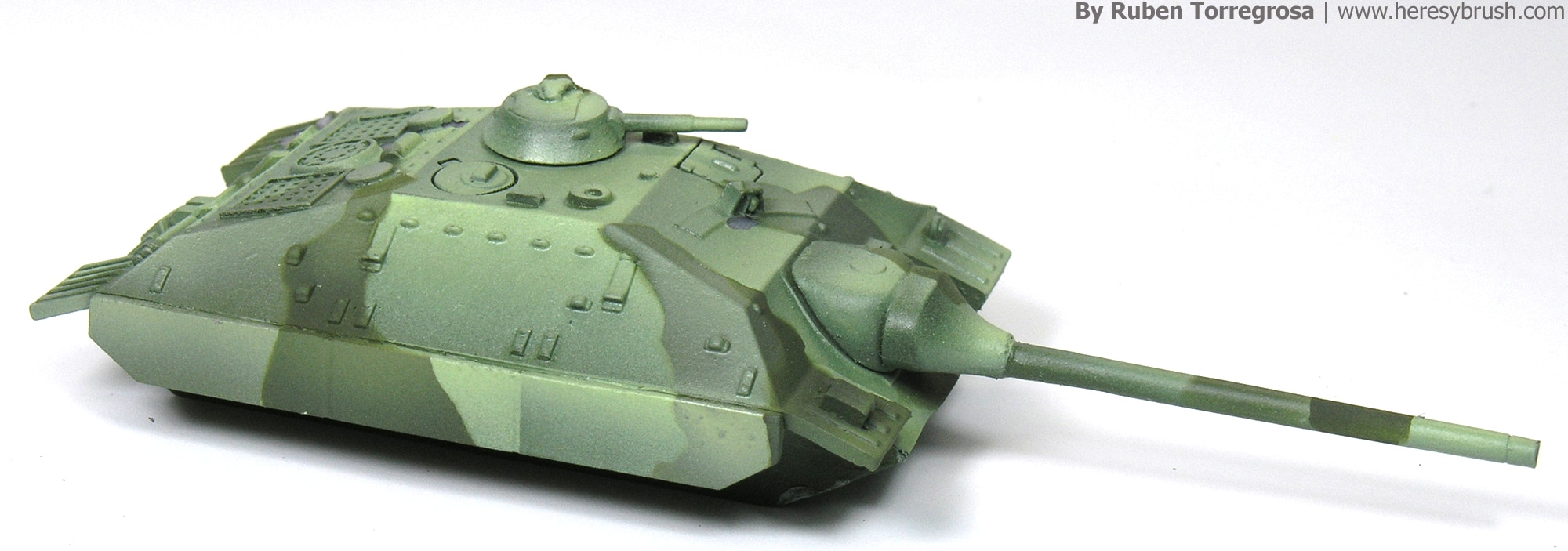
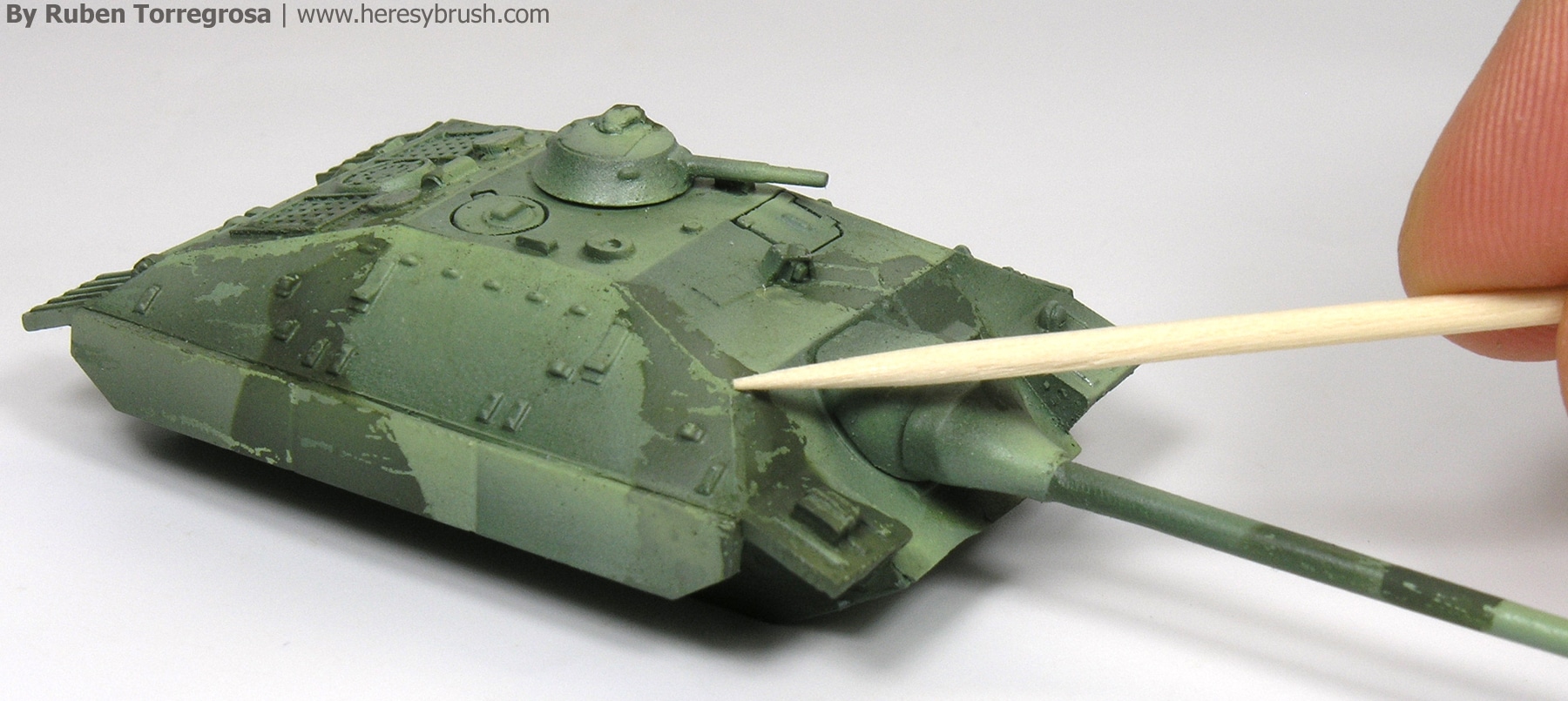















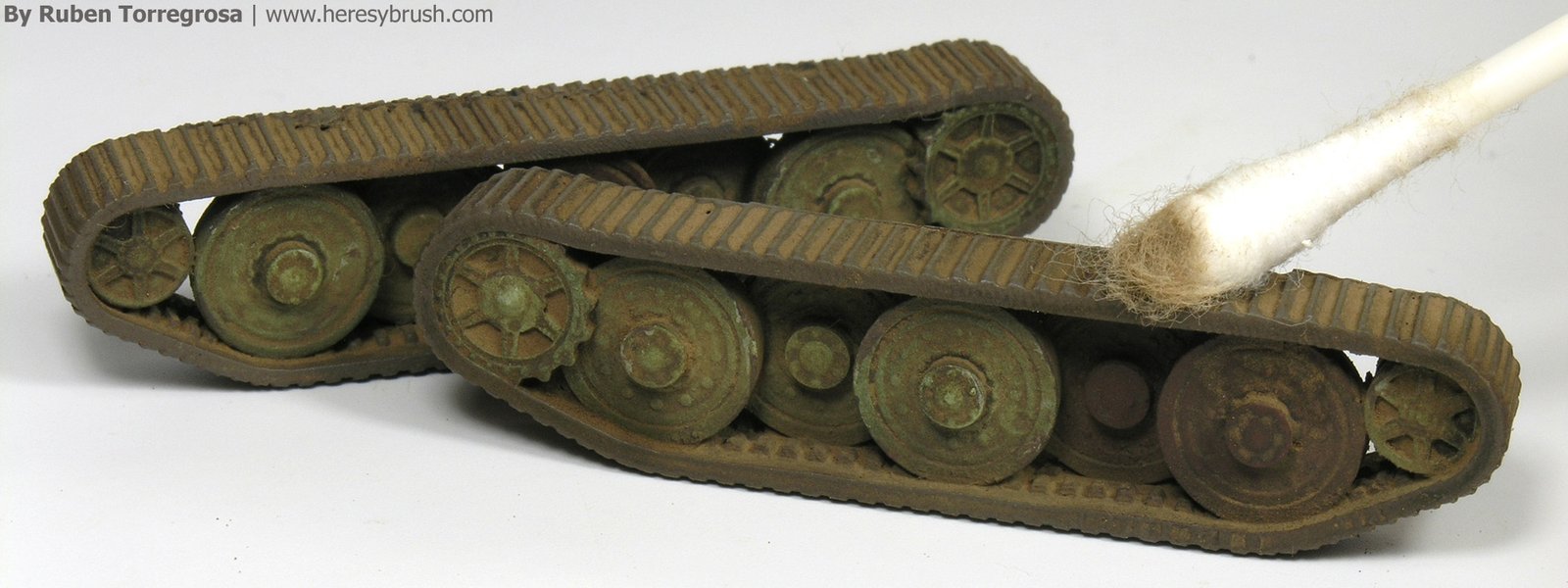
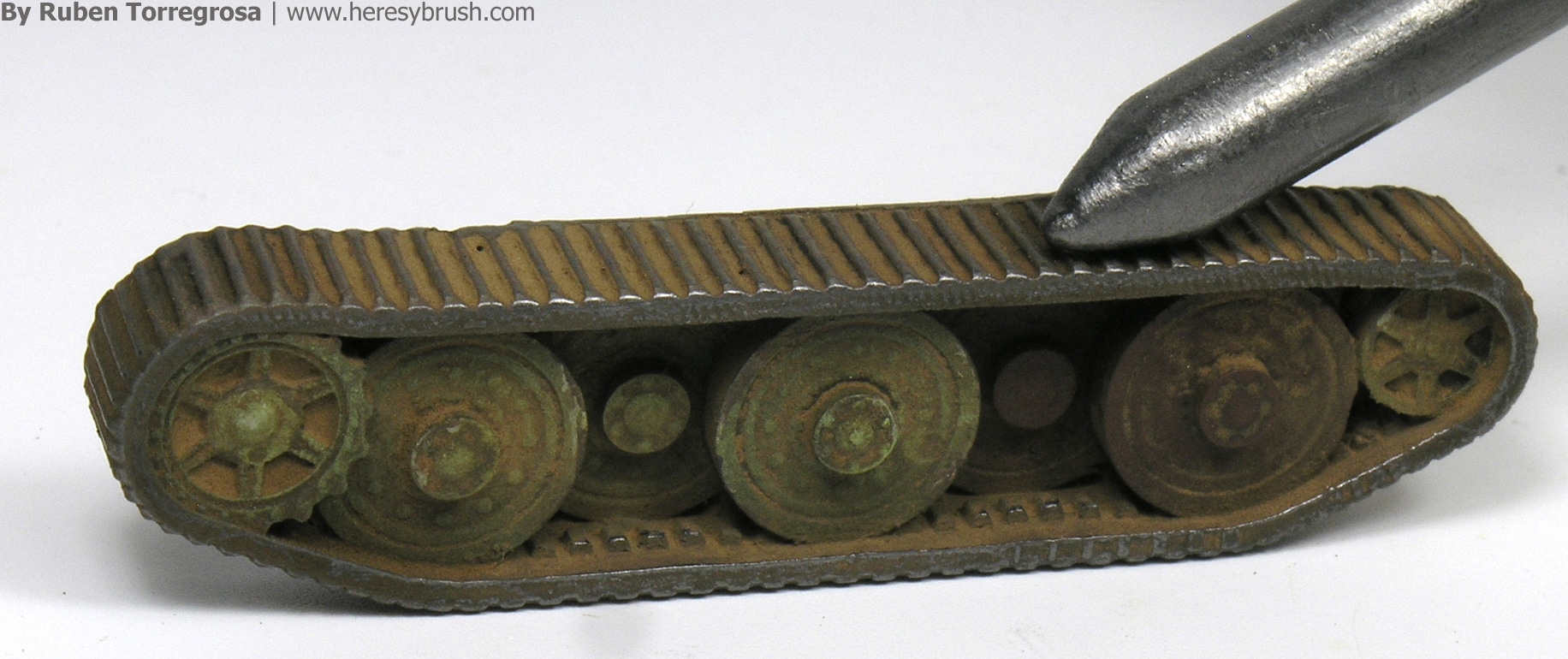
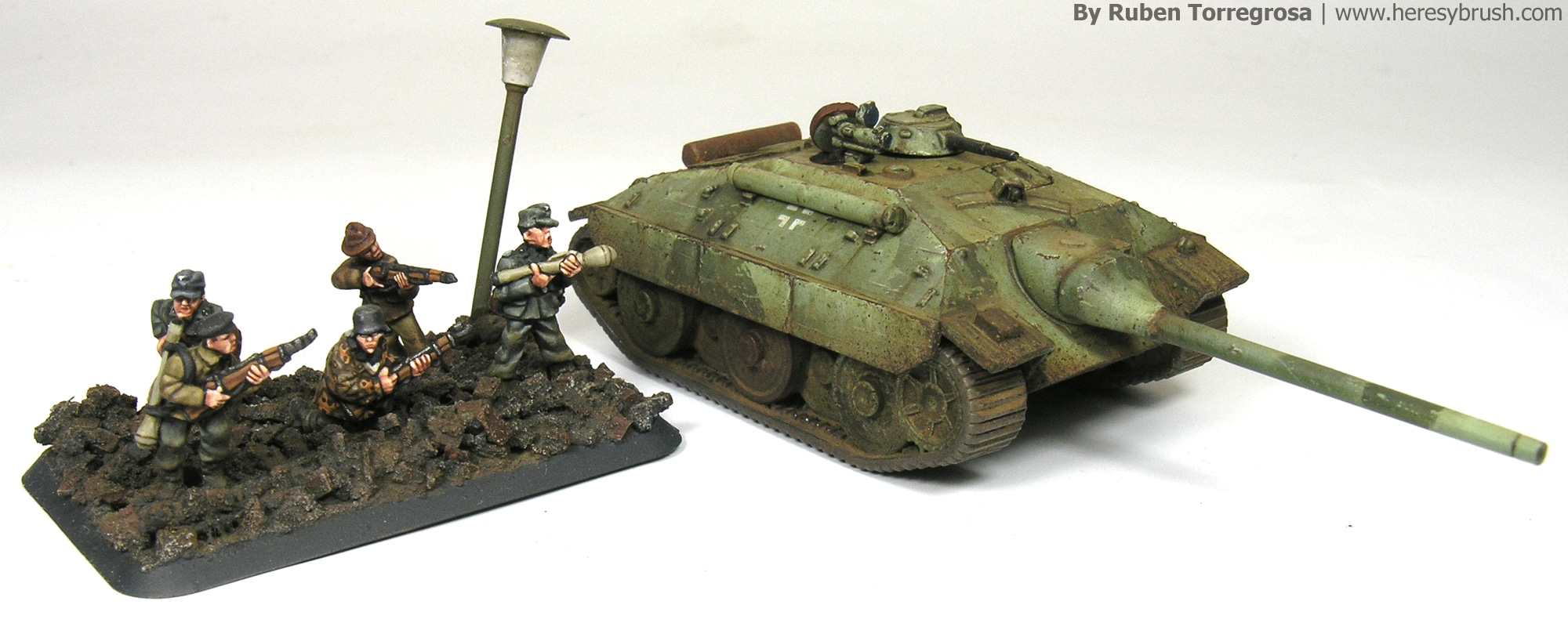
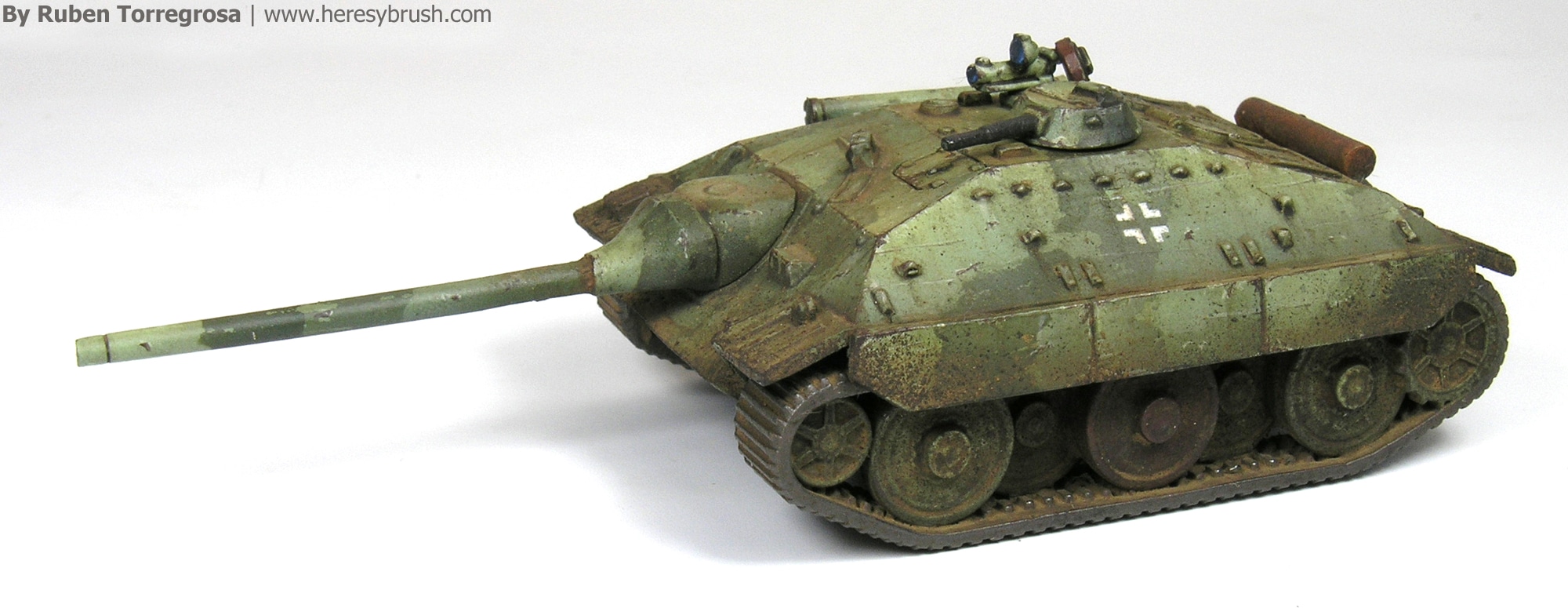
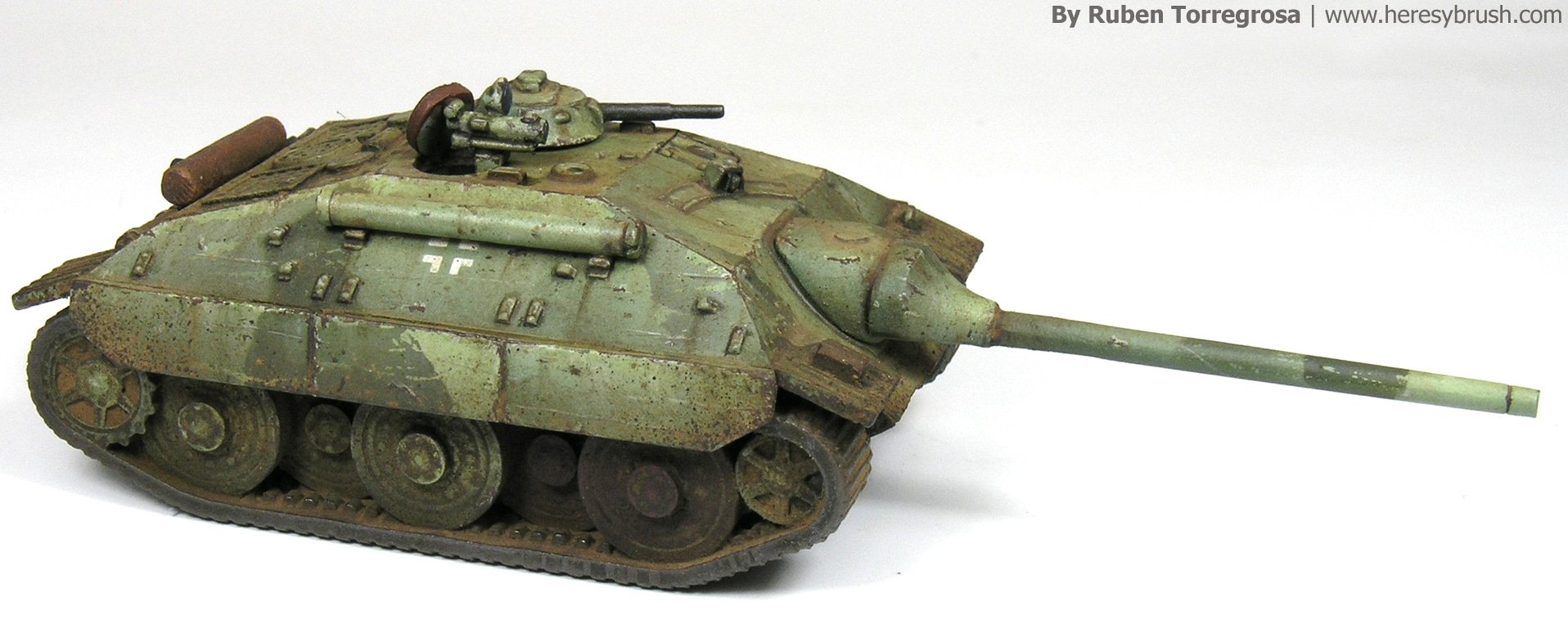
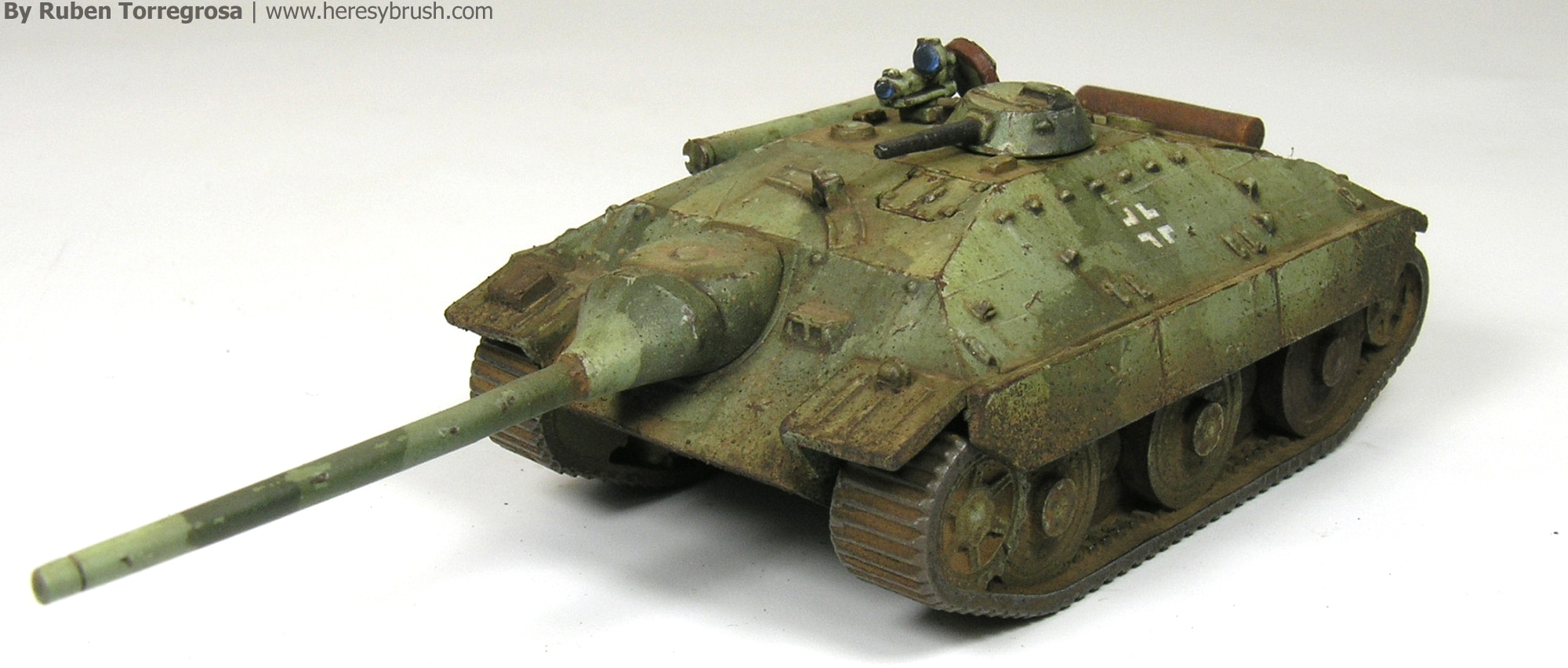
m M34 Taylor US Superheavy Tank (one resin kit with pewter accessories and rare earth magnets for the turret)